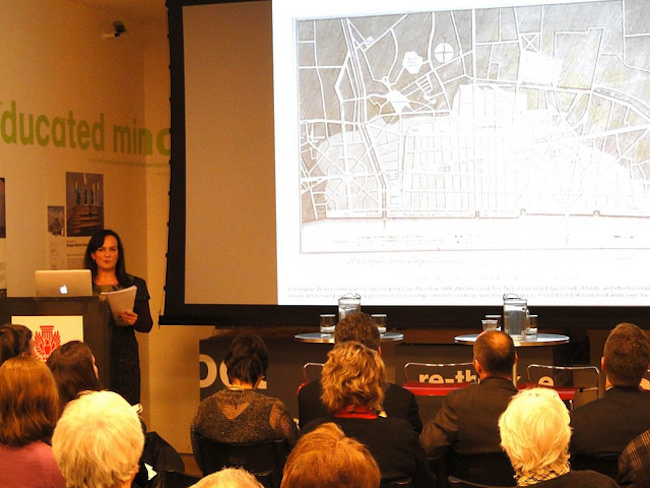
From art to urbanism
Interview with an architecture expert Lucy Bullivant
20/12/2018
Lucy Bullivant was one of the speakers at the public discussion held as part of Latvia Day at the London Design Biennale, where experts in the fields of creative industries, design and social anthropology from Latvia and the UK were invited for an active exchange of opinions. Latvia participated in the biennale with the interactive installation Matter to Matter created by designer Artūrs Analts and produced by the Latvian Museum of Decorative Arts and Design. It was awarded the gold medal for the best exposition design. Latvian participation in the London Design Biennale is part of the Latvian Centenary programme. Now the awarded installation Matter to Matter is on exhibition at the Museum of Decorative Arts and Design in Riga.
Bullivant is an architecture curator, author, critic and cultural historian with a PhD in adaptive planning tools and processes from the Sir John Cass School of Art, Architecture and Design at London Metropolitan University. She is an Honorary Fellow of the Royal Institute of British Architects. Bullivant became an adjunct professor at Syracuse University in London in 2013, teaching a new elective course in urban design history and theory. She writes for the magazines The Plan, Domus and Volume and contributes to The Guardian. Bullivant is the founder and editor-in-chief of urbanista.org, a webzine of critical perspectives on contemporary urban design.

Lucy Bullivant at her lecture. Publicity photo
You began your professional activities as an art curator and director of open art exhibitions. Why did you switch from art to architecture and urbanism?
I did it in order to professionally explore more multidisciplinary approaches. After getting my MA at the Royal College of Art in London, I became self-employed and was open to wider possibilities for work commissions from different bodies and firms, and not narrowly limited by the career ladder within one organisation.
I began to be internationally nomadic, working in Japan, and then with German, Italian and Dutch clients. These exciting commissions were largely focused on architecture and design. Gradually and via some innovative design exhibitions I curated in the UK and Japan, by starting to write for magazines like Domus and RIBA Journal and to write books on architecture, I explored a lot of territory, culturally, theoretically, socially and geographically.
What do you find are the most relevant issues in urbanism nowadays?
Strategies for sustainable, inclusive and equitable futures.
Why are these issues so relevant?
Because there is an acute need to reinvent urban design and placemaking practices in the 21st century to improve human development and wellbeing and to assist economic growth and political stability. Visions and strategies have to be focused on empirical research and critical assessments of situations and conditions. They should combine multi-faceted social, economic and ecological priorities, for example, for health and wellbeing through urban design, and places as crucibles of new sustainable economies through intimate ecologies of space and activities interfaced in new ways. For example, making the best use of a building throughout its daily, monthly, seasonal or annual cycle. Participatory placemaking involving local people – who are, after all, experts in where they live and work – and community ownership, through community and trusts, are both growing forces that will overcome the disconnect between people and place.
Are smart cities still a relevant issue?
It’s a marketing slogan. It’s control for control’s sake. We already have smart cities. The UK has more CCTV cameras than any other country in the world. We already live in a so-called smart world.
The curators of this year’s Rotterdam International Architecture Biennale insisted that architecture has become urbanism. Do you agree with this statement?
Not really. Of course, a lot of architecture today has aspirations to improve the city and the lot of city dwellers, but this statement is too much of a generality. Also seeing as many architects like more rural settings and more hermetic statements. Architecture today varies immensely, and a number of new buildings have a strong regenerative impact on their wider contexts. For example, Tate Modern and the GLA buildings in the South Bank of London, transforming the riverside areas of Bankside and London Bridge into pleasant, stimulating and versatile public spaces. Especially compared with their past identities as relatively dangerous locations.
But that is not the same as urbanism, combining the different logics of enquiry: design, social sciences and physical sciences. Urbanism is about cultivating an understanding of all the issues relating to cities in order to outline visions and strategies for sustainable, inclusive and equitable futures. Progressive urbanism does not reflect the ethos of many of its 20th-century pioneers, such as Henri Lefebvre and Manuel Castells, and the majority of architectural projects do not necessarily defend the right to the city as, say, Lefebvre would argue for, but instead, the right to be seen and see the city with consumption as important as interaction.
Architecture is, regrettably, not always made with these enlightened priorities in mind. On the contrary: through the prism of the developer’s vision, the goal is narrowly about capitalising on land value and social selection and control. But when an architectural project – possibly a modest one in terms of budget and size – is realised and fulfils all these needs, it is amazing. The work of the British architects’ group Assemble is instructive in this respect, for example.
Lucy Bullivant with colleagues at the London Design Biennale. Publicity photo
The curators of the Rotterdam International Architecture Biennale also made the statement that there are too many people and too little space on our planet. Do you agree with this pessimistic forecast for the future of our planet?
I am more interested in a regional focus, where you perceive areas of growth and shrinking areas, because applying planning tools to deal with imbalances of this kind has a lot of significance for the sustainability of regions and their conurbations and individual neighbourhoods. I am also more interested in qualitative perceptions of density through good planning. Also, staying away from scaremongering about population growth, which, for example, in the UK is used to fuel fear and resentment.
Rem Koolhaas has focused his interest on the countryside.
Yes, Rem is very interested in that. In public discourse, the countryside is neglected or seen as off-limits. For example, the Green Belt, where you cannot build, is kept secret or trivialised. Rem uses insights about the countryside to speculate about tomorrow, arguing that it has become the frontier of transformation, encompassing AI and automation, genetic experimentation, political radicalisation, mass and micro migration, large-scale regional management, human-animal ecosystems, subsidies and tax incentives, and the impact of the digital on the physical world.
Do you see problems in the UK?
In the UK, problems among rural communities in England, such as a lack of affordable housing and public transport, have been ignored for many years. In the countryside people are healthier, kids do better at school, and the scenery is magnificent, but there are also huge challenges which threaten to change the face of rural living. Arguably, the root of many of the problems is housing. The average house price in rural areas is more than eight times the average income. In urban areas it’s estimated to be 6.8.
With house prices so high, there are villages where the pub and shop have been sold and converted into houses. The real estate is worth much more as a home than as a business. Indeed, some villages have now lost their pub, shop or post office, school and even church, as they are all increasingly snapped up to be converted into housing. In parts of the UK today, villages have become little more than dormitories – a collection of houses with little to offer the residents any sense of community. Only when a pioneering outfit such as the Hauser & Wirth gallery in Somerset or some other community asset is set up, is that formula shifted.
Tackling rural housing is a tricky business, and successive governments have struggled to find a solution. It is generally agreed that it would be a good thing to have affordable housing for key workers such as teachers, nurses and police officers. How to achieve that is still a work in progress. It all means that many young people who have grown up in rural areas are having to move out, unable to afford to live in their own communities. What’s left is an ageing population and often a poor one. In contrast to perceptions, the British countryside is not all about Range Rovers, green wellies and a festival every summer. It’s estimated that 980,000 households in rural Britain are below the official poverty line.
There are signs that some of the basic economic forces which impact on life in the countryside may be shifting. The increasing availability of broadband is crucial. It is now perfectly possible for office employees to work from home, and increasing numbers of people seem to be doing just that. Broadband also offers the chance for new businesses to start up in isolated areas. The social implications of telecommuting are major. If more people stay in rural areas during the day, rather than travelling into town for work, it could be good news for the local shop, garage or other local services. But improved public transport is vital as part of the sustainability of rural life.
Last year, a report found that the UK public appears to have a rosy view of farming life, with one of four UK adults liking the idea of giving up their day job and working on a farm. However, the findings highlight a disconnect between the positive perception and the tougher realities of the profession. The Fund’s cash-flow crisis in farming report found 50% of UK farmers no longer make a living from farming alone.
And what about wild nature?
Biodiversity in the UK is in trouble, with more nature lost than the global average, according to a new measure detailed in the State of Nature report. The study, from a collaboration of over 50 wildlife organisations, said: “We are among the most nature-depleted countries in the world.” The study showed that 56% of species are in decline.
It suggests that conservation projects could help turn things around. The practice of rewilding gives power back to nature, setting the wheels in motion for the wilderness to grow without human intervention. Natural areas are restored, native animals and plants are reintroduced and protected. Rewilding Britain, an environmental charity, says that the benefits for nature are huge, with biodiversity, water security, and flood mitigation all being results of rewilding. The social benefits are also proven, with evidence strongly supporting the theory that health and wellbeing can be improved through connection with nature.

Lucy Bullivant. Publicity photo
